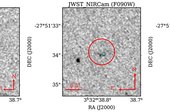 IIA EAPPACHEN, D
IIA EAPPACHEN, DNew JWST redshifts for the host galaxies of CDF-S XT1 and XT2: Understanding their nature
CDF-S XT1 and XT2 are considered two “canonical” extragalactic fast X-ray transients (FXTs). In this work, we report new constraints on both FXTs, based on recent JWST NIRCam and MIRI photometry, as well as NIRspec spectroscopy for CDF-S XT2 that allow us to improve our understanding of their distances, energetics, and host galaxy properties compared to the pre-JWST era.
Methods. We use the available HST and JWST archival data to determine the host properties and constrain the energetics of each FXT based on spectral energy distribution (SED) photometric fitting.
Results. The host of CDF-S XT1 is now constrained to lie at zphot = 2.76+2.21-0.13, implying a host absolute magnitude MR = −19.14 mag, stellar mass M* ≈ 2.8 × 108 M⊙, and star formation rate SFR ≈ 0.62 M⊙ yr−1. These properties lie at the upper end of previous estimates, leaving CDF-S XT1 with a peak X-ray luminosity of LX, peak ≈ 2.8 × 1047 erg s−1. We argue that the best progenitor scenario for XT1 is a low-luminosity gamma-ray burst (GRB), although we do not fully rule out a proto-magnetar association or a jetted tidal disruption event involving a white dwarf and an intermediate-massive black hole. In the case of CDF-S XT2, JWST imaging reveals a new highly obscured component of the host galaxy, previously missed in HST images, while NIRspec spectroscopy securely places the host at zspec = 3.4598 ± 0.0022. The new redshift implies a host with MR = −21.76 mag, M* ≈ 5.5 × 1010 M⊙, SFR ≈ 160 M⊙ yr−1, and FXT LX, peak ≈ 1.4 × 1047 erg s−1. The revised energetics, similarity to X-ray flash event light curves, small host offset, and high host SFR favor a low-luminosity collapsar progenitor for CDF-S XT2. Although a magnetar model is not ruled out, it appears improbable.
Conclusions. While these HST and JWST observations shed light on the host galaxies of XT1 and XT2, and by extension, on the nature of FXTs, a unique explanation for both sources remains elusive. Rapid discovery, for instance, with the Einstein Probe satellite, and contemporaneous multiwavelength detections of FXTs remain essential for clarifying the nature of FXTs.
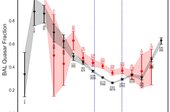 IIA VIVEK, M
IIA VIVEK, MBroad absorption line outflows are common in low Eddington ratio active galactic nuclei
Broad absorption line (BAL) quasars exhibit significant outflows, offering insights into active galactic nucleus (AGN) feedback. While typically associated with high Eddington ratios, BAL quasars also occur in low Eddington ratio regimes, which remain poorly understood. The aim of this study is to compare BAL properties and variability across these regimes.
Aims. We investigate the occurrence rates, absorption characteristics, and variability of BAL quasars at low and high Eddington ratios.
Methods. Using the SDSS DR16 quasar catalog, we selected a redshift-matched control sample to compare low and high Eddington ratio BAL quasar sources. We first examined the BAL fraction as a function of Eddington ratio. Key absorption parameters (equivalent width, absorption line width, velocity range, and depth) were analyzed, and a multi-epoch variability study was conducted using repeat spectra, followed by a comparison of parameter distributions between the two samples.
Results. For the first time, we report an increase in the BAL fraction toward low Eddington ratios, in addition to the previously known trend of high BAL fraction at high Eddington ratios. While high Eddington sources show extreme absorption features, overall distributions are statistically similar except for maximum outflow velocity. No significant variability differences were observed. The correlation between outflow velocity, Eddington ratio, and luminosity supports the role of radiation pressure in driving quasar outflows. For low Eddington ratios, additional mechanisms, such as softer SEDs, larger outflow distances, and thickened accretion disks from radiatively inefficient processes, likely drive outflow formation.
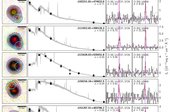 IIA RAVI JOSHI
IIA RAVI JOSHIBaryonic Ecosystem IN Galaxies (BEINGMgII) II. Unveiling the nature of galaxies harbouring cool gas reservoirs
We search for the galaxies associated with the intervening Mg II absorbers over a redshift range of 0.4 ≤ z ≤ 1 using imaging data from DESI Legacy Imaging Surveys and measure the redshift based on the direct detection of nebular emission in the background quasar spectra from the SDSS survey. We find 270 Mg II absorbers associated with strong O [II] or O [III] and Hβ nebular emissions, at a 2.5σ level. Among them, for 213 Mg II absorbers, we detect an absorber host galaxy at impact parameters of 4 ≤ ρ ≤ 16 kpc, including three absorbers associated with a galaxy pair, with a best-fit galaxy spectral energy distribution model based on multi-passband photometric data from DESI Legacy Imaging surveys, supplemented with the infrared VISTA and unWISE imaging surveys. The detection rate of the Mg II absorber host with strong O [II] nebular emission in the finite SDSS fibre of a 2–3 arcsec diameter increases from 0.2% to ∼3% with an increasing equivalent width from 0.3 Å to ∼3.5 Å, which remains near-constant across the probed redshift range. The associated Mg II host galaxies exhibit a wide range of stellar mass from 7.94 ≤ log(M⋆/M⊙)≤11.11, with an average star formation rate (SFR) of 5.81 M⊙ yr−1. The Mg II absorber hosts selected based on O [II] nebular emission mostly exhibit active star-forming systems including 13.4% starburst systems, but 10.2% with a suppressed SFR. The near-constant absorption strength at low-impact parameters suggests a high gas covering fraction. We find that the Mg II equivalent width (W2796) positively correlates with the SFR and specific SFR, likely indicating their wind origin. The average velocity offset between the host and the absorber suggests that the Mg II gas is bound within the dark matter halo.
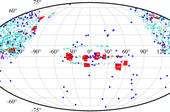 IIA MOUSUMI DAS
IIA MOUSUMI DASFirst search for high-energy neutrino emission from galaxy mergers
he exact sources of high-energy neutrinos detected by the IceCube neutrino observatory still remain a mystery. For the first time, this work explores the hypothesis that galaxy mergers may serve as sources for these high-energy neutrinos. Galaxy mergers can host very high-energy hadronic and photohadronic processes, which may produce very high-energy neutrinos. We perform an unbinned maximum-likelihood-ratio analysis utilizing the galaxy merger data from six catalogs and 10 years of public IceCube muon-track data to quantify any correlation between these mergers and neutrino events. First, we perform the single source search analysis, which reveals that none of the considered galaxy mergers exhibit a statistically significant correlation with high-energy neutrino events detected by IceCube. Furthermore, we conduct a stacking analysis with three different weighting schemes to understand if these galaxy mergers can contribute significantly to the diffuse flux of high-energy astrophysical neutrinos detected by IceCube. We find that upper limits (at 95% CL) of the all flavor high-energy neutrino flux, associated with galaxy mergers considered in this study, at 100 TeV with spectral index Γ =−2 are 1.11×10−18, 3.69 ×10−19 and 1.02×10−18 GeV−1 cm−2 s−1 sr−1 for the three weighting schemes. This work shows that these selected galaxy mergers do not contribute significantly to the IceCube detected high energy neutrino flux. We hope that in the near future with more data, the search for neutrinos from galaxy mergers can either discover their neutrino production or impose more stringent constraints on the production mechanism of high-energy neutrinos within galaxy mergers.
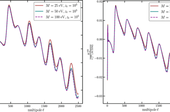 IIA SUBINOY DAS
IIA SUBINOY DASCosmological constraints on mass-varying dark matter
As one of the fundamental unknowns of our Universe, the mass of dark matter remains to be a topic of great interest. We consider the possibility of a time-variation of the dark matter mass. We study the cosmological constraints on a model where the dark matter mass transitions from zero to a finite value in the early Universe. In this model, the matter power spectrum exhibits power suppression below a certain scale that depends on the epoch of transition, and the angular power spectrum of the cosmic microwave background shows a distinctive phase shift and power suppression at small scales. We use the latest cosmic microwave background data and the 𝑆8 priors from weak lensing data to place a lower limit on the transition redshift. We also find that the data from the Atacama Cosmology Telescope (ACT) show a mild preference for the mass-varying dark matter model over Λ Cold Dark Matter (ΛCDM).
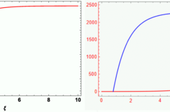 IIA SANVED KOLEKAR
IIA SANVED KOLEKARWigner distributions in Rindler spacetime and nonvacuum Minkowski states
In the 1970s, Fulling, Davies, and Unruh demonstrated that the vacuum state perceived by an inertial observer in Minkowski space appears as a thermal bath to a uniformly accelerated observer. We explore the transformation of the Wigner distribution of a real scalar field from an inertial to a Rindler frame, utilizing both Minkowski and Unruh modes. We present a general expression for the reduced Wigner distribution for a specific set of massless scalar field configurations, and validate it against known distributions within this set. This includes arbitrary Gaussian states of Unruh-Minkowski modes, the Minkowski vacuum state, the Rindler vacuum, and the thermal bath of Unruh particles. Additionally, we analyze several other distributions, such as a peaked frequency distribution, a slight deviation from the Minkowski vacuum, and a distribution with a fermionic component in the Rindler frame. The conclusions are discussed.
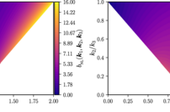 IIA DEBIKA CHOWDHURY
IIA DEBIKA CHOWDHURYCross-correlation between the curvature perturbations and magnetic fields in pure ultraslow roll inflation
Motivated by the aim of producing significant number of primordial black holes, over the past few years, there has been a considerable interest in examining models of inflation involving a single, canonical field, that permit a brief period of ultraslow roll. Earlier, we had examined inflationary magnetogenesis—achieved by breaking the conformal invariance of the electromagnetic action through a coupling to the inflaton—in situations involving departures from slow roll. We had found that a transition from slow roll to ultraslow roll inflation can lead to a strong blue tilt in the spectrum of the magnetic field over small scales and also considerably suppress its strength over large scales. In this work, we consider the scenario of pure ultraslow roll inflation and show that scale invariant magnetic fields can be obtained in such situations with the aid of a nonconformal coupling function that depends on the kinetic energy of the inflaton. Apart from the power spectrum, an important probe of the primordial magnetic fields are the three-point functions, specifically, the cross-correlation between the curvature perturbations and the magnetic fields. We calculate the three-point cross-correlation between the curvature perturbations and the magnetic fields in pure ultraslow roll inflation for the new choice of the nonconformal coupling function. In particular, we examine the validity of the consistency condition that is expected to govern the three-point function in the squeezed limit and comment on the wider implications of the results we obtain.
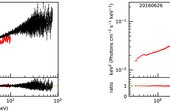 IIA SANTANU MONDAL
IIA SANTANU MONDALExploring the disc-jet scenario in 3C 273 using simultaneous XMM-Newton and NuSTAR observations
The well-studied active galactic nucleus (AGN) 3C 273 displays characteristics of both jetted-AGNs and Seyfert galaxies, which makes it an excellent source to study the disc-jet connection in AGNs.
Aims. We aim to investigate the disc-jet scenario in 3C 273 using broad-band (0.3–78 keV) X-ray spectra from XMM-Newton and NuSTAR.
Methods. We used simultaneous XMM-Newton and NuSTAR observations of 3C 273 carried out between 2012 and 2024. The 0.3–78 keV X-ray spectra were first fitted with a simple power law (PL) and then with the accretion-ejection-based JeTCAF model. The JeTCAF model accounts for emission from the jet, which extends up to the sonic surface. In this framework, a reflection hump above 10 keV can also arise due to the bulk motion Comptonization of coronal photons by the jet.
Results. We find that the simple PL did not provide a good fit, leaving significant residuals at energies below 1.5 keV. All the spectra were fitted well by the JeTCAF model. The weighted-averaged black hole mass of (7.77 ± 0.30) × 108 M⊙ obtained from the JeTCAF model is comparable with the previous estimates based on reverberation mapping observations and accretion disc models.
Conclusions. The 0.3–78 keV X-ray emission of 3C 273 can be fit by the accretion-ejection-based model in which the corona and the jet on top of it make significant contributions to the X-ray flux. The Doppler boosting factor estimated from the jet flux ranges from 1.6 to 2.2, consistent with the lower limit from the literature.
 IIA STALIN, C. S
IIA STALIN, C. SStudy of giant radio galaxies using spectroscopic observations from the Himalayan Chandra Telescope
We present the results of spectroscopic observations of host galaxies of eleven candidate giant radio galaxies (GRGs), powered by active galactic nuclei (AGNs), conducted with the 2-m Himalayan Chandra Telescope (HCT). The primary aim of these observations, performed with the Hanle Faint Object Spectrograph Camera (HFOSC), was to secure accurate spectroscopic redshifts, enabling precise calculations of their projected linear sizes. Based on these measurements, we confirm all eleven sources as giants, with linear sizes ranging from 0.7 to 2.9 Mpc, including ten GRGs and one giant radio quasar (GRQ). One of the GRGs shows evidence of a potential AGN jet-driven ionised outflow, extending up to ∼12 kpc, which, if confirmed, would represent a rarely observed feature. Two of the confirmed GRGs exceed 2 Mpc in size, which are relatively rare examples of GRGs. The redshifts of the host galaxies span 0.09323 ≤ z ≤ 0.41134. Using the obtained spectroscopic data, we characterised their AGN states based on the optical emission line properties. To complement these observations, archival radio and optical survey data were utilised to characterise their large-scale radio morphology and estimate projected linear sizes, arm-length ratios, flux densities, luminosities, and core dominance factors. These results provide new insights into the properties of GRGs and form a critical foundation for further detailed studies of their environments, AGN activity, and evolution using future high-sensitivity optical and radio datasets.
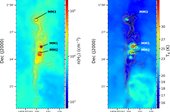 IIA ARCHANA SOAM
IIA ARCHANA SOAMB-fields and Dust in Interstellar Filaments Using Dust Polarization (BALLAD-POL). III. Grain Alignment and Disruption Mechanisms in G34.43+0.24 Using Polarization Observations from JCMT/POL-2
Polarization of starlight and thermal dust emission due to aligned non-spherical grains helps us to trace magnetic field (B-field) morphology in molecular clouds and to study grain alignment mechanisms. In this work, we study grain alignment and disruption mechanisms in a filamentary infrared dark cloud G34.43+0.24 using thermal dust polarization observations from JCMT/POL-2 at 850 μm. We study three regions: the North harboring the MM3 core, the Center harboring the MM1 and MM2 cores, and the South harboring no core. We find the decrease in polarization fraction P with increasing total intensity and gas column density, known as polarization hole. To disentangle the effect of magnetic field tangling on the polarization hole, we estimate the polarization angle dispersion function. We find depolarizations in the North and Center regions are due to a decrease in the net alignment efficiency of grains, but in the South region, the effect of magnetic field tangling is significant to cause depolarization. To test whether the radiative torque (RAT) mechanism can reproduce the observational data, we calculate minimum alignment and disruption sizes of grains using RAT theory, and our study finds that the RAT alignment (RAT-A) mechanism can explain the depolarizations in the North and Center regions where the B-field tangling effect is less important, except for core regions. We find hints of RAT disruption (RAT-D) in the core regions of MM3 in the North, and MM1 and MM2 in the Center. We also find that the high P value of around 8%–20% in the outer regions of the filament can potentially be explained by the magnetically enhanced RAT alignment mechanism.